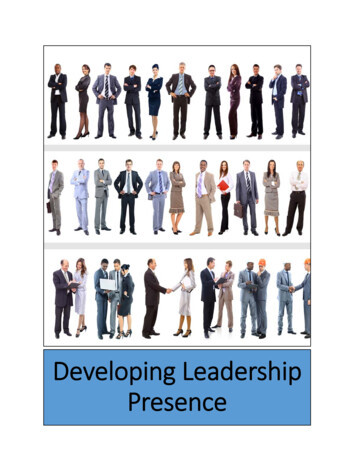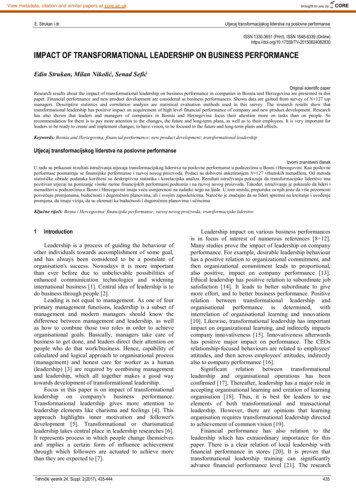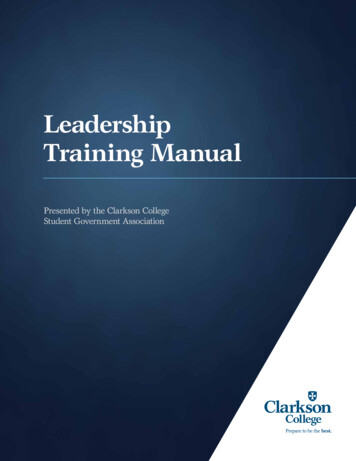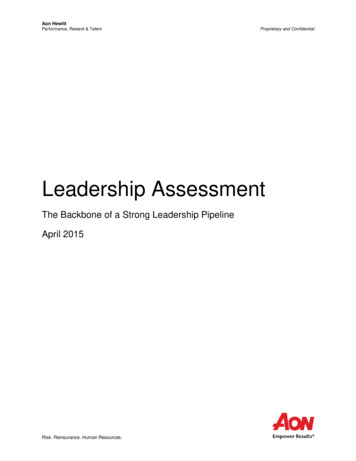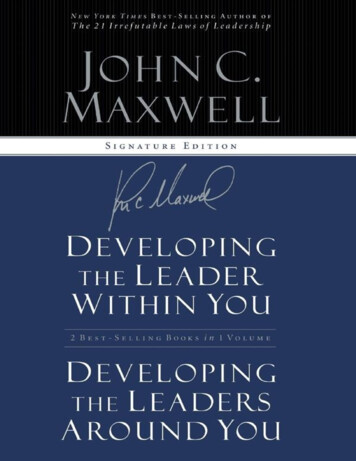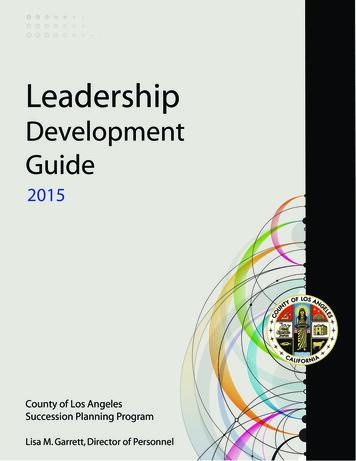
Transcription
LeadershipDevelopmentGuide2015County of Los AngelesSuccession Planning ProgramLisa M. Garrett, Director of Personnel
D H RDepartment of Human ResourcesCounty of Los Angeles
Introduction . 5Background . 5Purpose of this Guide . 5Who Should Use This Guide . 5The Succession Planning Framework . 6How Leaders Learn . 8Leadership Development Process . 10Assess: Identify Needs . 11Design: Construct the Plan . 12Share: Communicate the Plan . 15Act: Implement the Plan . 16Evaluate: Assess Outcomes . 17Conclusion. 18Sources. 19Authors . 20AppendicesA. Leadership CompetenciesB. Development Approach based on Leadership Evaluation “Three-Box” CategoriesC. Conducting Development ConversationsD. Sample Development AssignmentsE. Individual Leadership Development Plan Template, Instructions, and Sample PlanF. Using PerformanceNet to Document Development Plans
Succession PlanningTo enable the County to proactively address leadership turnover by identifying vulnerabilitiesand providing resources to assist in developing the County’s leaders.Workforce Development MAPP Behavior Creates and maintains a succession plan to identify, develop, and retain key talent in order toincrease the availability of experienced and capable employees who are prepared to assumemanagement roles as they become available.PAGE 4
IntroductionBackgroundSuccession planning is an essential strategy for every organization. One of our most important tasksas effective leaders is to prepare our future leaders. The Board of Supervisors reinforced thisexpectation on January 24, 2012 by issuing the directive to makesuccession planning a mandatory Management Appraisal and20% of MAPP employeesPerformance Plan (MAPP) behavior. As succession planning increasesare projected to retirewithin three years.the County’s overall leadership “bench strength,” it will also create thepool of promotion-ready employees needed to respond to retirementand other forms of turnover.The Department of Human Resources (DHR) and line department human resources professionals canorchestrate County- and department-wide approaches to analyzing and strengthening the leadershippipeline. However, as an individual manager, you see firsthand an employee’s performance overtime and directly observe that employee’s ability to handle challenges. Thus, you have the greatestinfluence to create an environment where employees can be developed for higher-level leadershiproles.Purpose of this GuideThis Guide is a resource for managers seeking to develop the leadership competencies of their MAPPemployees. Specifically, this Guide will provide the following: Brief guidelines for understanding the Countywide succession planning program and amanager’s role in implementing it Methods for developing and executing leadership development plans An Individual Leadership Development Plan (ILDP) templateWho Should Use This GuideThe information presented in this Guide may be useful for any manager seeking to develop his/heremployees. However, it has been written particularly for those who have completed the LeadershipEvaluation, which provides a structure for evaluating MAPP employees according to definedleadership competencies needed for success in positions at the next higher-level throughout theCounty. These leadership competencies have been provided in Appendix A.PAGE 5
The Succession Planning FrameworkThe following guidelines describe the County’s approach to succession planning and provide generalinformation to consider about the leadership development process. The County’s succession planning is different from traditional succession planning.Traditional succession planning programs emphasize the pre-selection of an employee to fill ahigher-level position when it becomes vacant. In contrast, the County’s succession planningprogram emphasizes development opportunity. Enhancing the leadership capacity of all potentialsuccessors is a good practice, as it increases the overall performance of the organization andincreases the pool of employees who are prepared for a higher-level position. Succession planning is intricately tied to career planning.Managers and their potential successors must have open, up-front discussions about futurecareer goals. Employees approach development assignments best when those assignments aredirectly linked to their specific career ambitions. An important part of succession planning iscommunicating the relevance between a development assignment and the responsibilities of thehigher-level position to which a potential successor aspires. Leadership development is different from regular employee development.Managers must always be engaged in developing their direct reports for success in their currentpositions. Development for higher-level positions is distinguished from this day-to-daydevelopment because it depends on the needs of the organization, the goals of the employee,and the availability of specific development opportunities (e.g., timing fiscal managementcompetency development to occur during an actual budget cycle). Leadership development should be carefully assessed from the context of the higher-levelposition and the employees’ ongoing performance in their current positions.Although the purpose of the leadership development effort is to assess employees’ performancewithin the context of the needs of next higher-level positions, managers must be cognizant not toput so much pressure on potential successors that employees are unable to successfully completethe responsibilities of their current positions. Succession planning should incorporate considerations of talent pools.The current model of succession planning and leadership development is based on developmentfor vertical advancement (i.e., to the position directly above). However, development forhorizontal advancement (i.e., to promotional opportunities in other functional units, divisions, ordepartments) is also important, particularly given that County employees move within theorganization.Departments are encouraged to develop talent pools for departmental positions that requiresimilar competencies. That is, the department should assess and develop groups of eligibleemployees – regardless of direct reporting relationships – to potentially advance into one ormore higher-level positions.PAGE 6
The following table describes the roles of the stakeholders in the succession planning process:RoleDepartment ofHuman ResourcesDepartment Head& ExecutiveManagementLine DepartmentHuman ResourcesDepartmentManagers &SupervisorsMAPPEmployeesResponsibilities Promote succession planning Provide information, analyses, resources, tools, and guidance todepartments Evaluate progress Set strategic direction and define succession planning leadershipdevelopment strategies Support succession planning leadership development efforts (e.g.,resource allocation, change management) Build a thriving culture where employee skills are valued andencouraged to grow Implement department’s succession planning leadershipdevelopment strategies Evaluate succession planning leadership development progress andsuggest changes Serve as a resource for line managers implementing IndividualLeadership Development Plans Understand competency requirements of leadership positions Evaluate employees and provide them with ongoing feedback Select leadership development assignments Implement Individual Leadership Development Plans with theirMAPP employees Actively participate in their own development Engage in self-awareness activities (e.g., self-reflection) Proactively seek out feedback from peers, managers, and clientsPAGE 7
How Leaders LearnA cornerstone of leadership development is that leadership capability is primarily learned throughexperience. An estimated 70% of leadership development occurs through experience-basedlearning.1 Furthermore, a guideline indicator of having gained the experience and “know how” to beconsidered an expert in a discipline is the accomplishment of 10,000 hours and/or 10 years of appliedwork experience.2 Leadership is a discipline that has its own required competencies, and thesecompetencies are best acquired through hands-on work experiences.Leadership development happens throughout employees’ professional work lives. Traditionally,employees acquire a variety of experiences as work-related needs arise. These work experiencesshape employees’ understanding of work operations and increase their confidence to effectivelyhandle growing levels of complexity. When employees have demonstrated a high level ofcompetence in a wide-array of challenging work functions and situations, they are moved intoleadership positions. This experience-based approach to leadership development is effective;however, it can be improved through the implementation of a more structured and guided approach.The goal of this Guide is to help make leadership development a directed path of actions instead ofan unplanned series of events. Employees can and do gain the levels of experience needed to ascendinto leadership roles; however, a more defined and guided process helps to ensure employees arefully prepared to promote in less time.One of the most effective methods to accomplish leadership development is through stretchassignments. Stretch assignments are hands-on, competency-specific work experiences that serve asgateways to attaining the experience needed to close competency development gaps. Leadingresearch describes several distinct characteristics that contribute to the effectiveness of stretchassignments. As described below, these characteristics should be incorporated into the leadershipdevelopment plans for potential successors.Effective stretch assignments include challenging work that forces employees to learn by adjusting (e.g., implementing majororganizational change, working across organizational boundaries, influencing people, workingwith ambiguity, etc.), which can motivate employees by requiring them to demonstrate theirability in new ways. However, the assignment needs to reflect a balance of being challengingwhile not being too challenging, which can turn into a moment of defeat (e.g., too cognitivelydemanding; too many restrictions, barriers, or constraints to overcome; too much fear offailure in full view of peers). quality work experiences that expand learning by including unfamiliar work assignments thatare multi-dimensional, have large scale and scope, and have major implications (i.e., highstakes).1McCall, M. W., Jr. (2010b)2Ericsson, K. A., & Charness, N. (1994)PAGE 8
Effective stretch assignments include (cont’d) multiple opportunities to perform the same or similar work within different contextualenvironments (i.e., experiencing nuances of the specific work situations), which allowsemployees to practice, apply previous lessons learned, and reach a higher level ofunderstanding and confidence. active, timely, constructive feedback provided by the manager to guide learning and reduceuncertainty about how to best accomplish the work. employee self-refection on the work experience through a systematic review of behaviorsand outcomes. Reflection or after-event reviews provide a means for employees to evaluatethe work situation and then discuss it with their manager to receive guidance. These reviewshelp to ensure the appropriate lessons were understood, which can help maximize thelearning potential from each work assignment. consideration of the timing for giving the assignment. Timing in this case represents amoment when employees areo in a ready learning state (e.g., willing, able, and in possession of the foundationalknowledge to accomplish the challenge);o accepting of the challenge and willing to accomplish it;o carrying a regular workload that enables time to focus on accomplishing the stretchassignment; ando given support via resources and the manager’s guidance to clear barriers to thesuccessful accomplishment of the assignment. the manager’s promotion of a learning environment byo involving employees in the stretch assignment and goal-setting decision-makingprocess (i.e., creating a participative, mutually-agreeable process);o defining effective and well-communicated learning goals;o encouraging employees’ to be willing and open to receive constructive feedback andreceive support (e.g., motivating the employee to rise to new levels ofaccomplishment);o creating a supportive work environment that encourages success and positivemovement forward while reducing employees’ feelings of uncertainty, risk of beingexposed (being “out there on their own”), and having to prove themselves again in anew environment; ando making employee development a cultural value and a strategic priority shown throughdaily work decisions and actions. recognition that leadership development is long-term and requires commitment.Leadership development is not an absolute, continuous linear process. There will be ups anddowns with plateaus as employees’ accomplishments accrue. tracking of employees’ growth across their entire career at the organization, whichinvolves building a portfolio of accomplished work experiences and maintaining a record ofthe employees’ leadership competency development levels.PAGE 9
Leadership Development ProcessThe Succession Planning Program operates with a Five-Phase Model (Model) for leadershipdevelopment, which is adaptable for County-, department-, and manager-level implementations.Provided below is a summary of the Model from the manager-level implementation perspective. Atthis point in the implementation of the Model, you are at Phase 1 and are moving into Phase 2.THE FIVE-PHASE MODELfor Managers of MAPP Employees-1ASSESSGoals Evaluate theeffectiveness of theILDP for eachemployee Share general ILDPsuccesses andlessons learned tosupport theCountywide anddepartmental “bigpicture” effortIdentify Needs-5EVALUATEAssessOutcomesGoals Assess each employee’spreparedness topromote to nexthigher-levelpositions-2DESIGNStrengtheningall MAPPemployeesby offering eachof themdevelopmentopportunities-4ACTConstructthe Plan-3SHAREImplementthe PlanCommunicatethe PlanGoals Implement each employee’sagreed-upon plan to enhanceleadership competenciesand portfolio of work experiencesGoals Understand eachemployee’sstrengths anddevelopmentneeds Identifydevelopmentassignments for eachemployee’s IndividualLeadership Development Plan(ILDP)Goals Document and obtainconsensus with eachemployee on the ILDPThe following section provides detailed information for completing the Phases of this Model.PAGE 10
PHASE 1: ASSESS – Identify NeedsPHASE 2PHASE 3PHASE 4PHASE 5Goal: Assess each employee’s preparedness to promote to next higher-level positions1. Complete the Leadership Evaluation, which provides a structure for evaluating the MAPPemployee according to defined leadership competencies needed for success in positions atthe next higher-level throughout the County.Note: MAPP employees have already been assessed through the Leadership Evaluation.For your reference, Leadership Evaluation screen shots are provided below.2. Reach out to the employee to determine whether he/she is interested in participating in a1-on-1 succession planning/leadership development meeting with you. Although DHR hasrecord of the participation selections each MAPP employee made in this regard during the2014-15 Leadership Evaluation implementation, we recommend that you contact theemployee to ascertain his/her current interest, which may differ from the previousparticipation selection.Proceed with Phases 2-5 for each employee who electsto participate in the succession planning/leadership development processPAGE 11
PHASE 2: DESIGN – Construct the PlanPHASE 1PHASE 3PHASE 4PHASE 5Goal: Understand the employee’s strengths and development needs1. Review the Leadership Evaluation completed for the employee to obtain an understandingof his/her development needs. This review should be two-fold. First consider theemployee’s specific competency strengths and shortcomings. Then consider the overallplacement of the employee within the Leadership Evaluation “Three-Box” categories.Appendix B provides general guidelines on the development approach to take withemployees based on their Three-Box rating.2. Meet with the employee to obtain a common understanding of the higher-level leadershipcompetencies and any development gaps that exist. This shared understanding can beachieved by discussing the results of the Leadership Evaluation, Leadership Self-Evaluation,and other self-assessments taken. The conversation may reveal and provide opportunityto correct misperceptions about the employee’s performance and/or potential. Examplequestions to address: Are there any competencies on which the two sets of ratings (i.e., manager andemployee) differ dramatically?How can the responsibilities of the next higher-level position and the specificLeadership Evaluation ratings be communicated to the employee while alsoconsidering the employee’s perspective?Although the conversation should focus on identifying and addressing leadershipdevelopment gaps, it is also important to discuss strengths the employee alreadypossesses in relation to the higher-level position. This can highlight the fairness of theevaluation process and boost the employee’s openness to constructive criticism aboutother competency areas.After agreeing on the competencies to be developed, prioritize and narrow them down toa reasonable number on which to focus.Appendix C provides sample questions for you to use when engaging your employee indevelopment planning conversations.PAGE 12
PHASE 1PHASE 2: DESIGN – Construct the PlanPHASE 3PHASE 4PHASE 5Goal: Identify development assignments for each employee’s Individual Leadership DevelopmentPlan (ILDP)3. Consider potential assignments that will develop the targeted competencies.3 Theseassignments should stimulate learning and “stretch” the employee beyond his/her currentlevel of expertise. Effective development assignments incorporate one or more of thechallenging characteristics described below.Characteristics of Effective Development AssignmentsUnfamiliar Responsibilitiesmanaging new or differentareas of workNew Directionscreating and managingstrategic changesInherited Problemsfixing problems thatpreviously existedBroad Scopemanaging work withmultiple functions or servicesLarge Scalemanaging work of great size (e.g.,workload, locations, employees)High Stakesmanaging work with critical outcomesor high pressure/visibilityResponsibility Without Authorityinfluencing peers, higher-level management, and other stakeholdersMAPP employees have most likely already experienced projects and assignments thatfeature these characteristics. However, tackling assignments with these challengingcharacteristics multiple times will strengthen employees’ ability to conquer thosechallenges and equip them to be better leaders. Additionally, keep in mind that achallenging assignment is not necessarily a developmental assignment. Employees coulduse existing strengths to successfully complete challenging projects. True leadershipdevelopment assignments are challenging and stretch employees beyond their comfortzones.3There may be instances in which a single stretch assignment could benefit multiple employees. If the assignmentcannot accommodate all of the employees, consider which employee should be assigned the development opportunitybased upon developmental need, interest, career goal, and/or perceived likelihood of achieving success.PAGE 13
PHASE 2: DESIGN – Construct the PlanPHASE 1PHASE 3PHASE 4PHASE 5Goal: Identify development assignments for each employee’s ILDP (cont’d)4. Brainstorm on the specific assignments to include in the ILDP. The following questions canhelp in this step: Which assignments have the most promise for learning?What other stakeholders (e.g., managers of other divisions or departments) wouldneed to be involved to make the stretch assignment happen?Which assignments are most appropriate and feasible given current responsibilities?How can the current position be modified to accommodate a challenging, higher-levelstretch assignment (e.g., rotational or temporary assignments)?Using this intentional approach, an employee who needs to develop negotiation, conflictmanagement, and flexibility competencies could be given the following stretchassignment:Negotiate a new contract for a major new department program with an existingservice provider that has been pushing for large price increases for existing services andkeep costs within a 15% increase of current contract expenditures.Successful completion of this assignment requires a full-range of leadership competencies.However, you would emphasize to the employee the three competencies the goal isintended to develop. Note that stretch assignments can also fulfill MAPP stretch goalrequirements.Appendix D lists examples of development assignments. These examples may serve asinspiration to identify potential assignments.PAGE 14
PHASE 1PHASE 2PHASE 3: SHARE – Communicate the PlanPHASE 4PHASE 5Goal: Document and obtain consensus with each employee on the ILDP1. Discuss the stretch assignments with the employee to obtain agreement. Be open tonegotiate with the employee, as the employee must have a voice in the process to takeownership of his/her development.2. Document the agreed-upon assignment in a formal ILDP. The plan should consist of thefollowing major elements:1. A definition of the assignment in terms of what will be accomplished or attempted2. A specific timeframe for completing the assignment3. The development target or goal (e.g., the specific competency or challengingcharacteristic to experience)4. The resources available to the employee5. The proposed specific actions or strategies for accomplishing the assignment6. The feedback methods (e.g., progress meetings)Appendix E provides a sample paper-format ILDP template. Appendix F providesinformation on using the County’s PerformanceNet to document and manage ILDPs.However, note that completing forms is not the focus of succession planning or leadershipdevelopment efforts. Your interactions with your employee drive the success of thesuccession planning leadership development effort.PAGE 15
PHASE 1PHASE 2PHASE 3PHASE 4: ACT – Implement the PlanPHASE 5Goal: Implement the employee’s agreed-upon plan to enhance the leadership competencies andportfolio of work experiences1. Provide support to the employee, which is a key element influencing the success ofdevelopmental experiences. As employees are engaged in implementing or executingdevelopment assignments, you can demonstrate support by showing willingness to provide the resources to fulfill the assignment.communicating confidence in the employee’s ability to achieve the learning goal.acknowledging and helping the employee manage any uncertainty associated withthe assignment.2. Provide feedback to the employee, which is another key element influencing the successof a developmental experience. Numerous types of feedback can be provided: Manager feedback. Performance feedback from managers often focuses onwhether employees successfully carry out their responsibilities. However,development assignments require feedback on how employees approach theirdevelopment assignments. Work with employees to understand how they arecarrying out their assignments and help them identify more effective practices andapproaches. Conduct after-event reviews throughout various stages of theassignment to provide timely feedback and guidance. Other employees’ feedback. Individuals directly involved in or impacted by thedevelopment assignment (e.g., direct reports, committee co-chairs, othermanagers, etc.) can provide valuable feedback that helps to pinpoint specific areasto prepare employees for their future leadership roles. Additionally, the employeecan consult with peers and colleagues who have met similar challenges to receiveinsight and guidance. Self-reflection. Encourage employees to keep a written record (i.e., work journal)of new knowledge and insights gained, and how they may apply them to futureexperiences. Additionally, employees should compare the current challenge topast experiences, looking for parallels, contrasts, and new approaches. Helpemployees recognize that what worked in the past may not work at higher levels.These reflections can occur at various increments and/or pivotal points in theassignment timeline.PAGE 16
PHASE 1PHASE 2PHASE 3PHASE 4PHASE 5: EVALUATE – Assess OutcomesGoal: Evaluate the effectiveness of the ILDP1. Assess outcomes to determine whether the employee developed the target leadershipcompetencies and strengthened the leadership pipeline by achieving the developmentalgoal. If you determine that the employee has not successfully developed the targetedleadership competencies, the development assignment can be revisited and the ILDPmodified.The progression of an employee’s development should be noted in the ILDP documentand/or the County’s PerformanceNet. In addition, communicate directly with theemployee about his/her development progress at multiple times throughout the year.This continual feedback will help the employee to be aware of his/her progress.Goal: Share general ILDP successes and lessons learned to support the Countywide anddepartmental “big picture” effort2. Participate in DHR’s periodic surveys to provide your feedback on the ILDPs you haveimplemented with your MAPP employees.3. Contribute your feedback on the department-level leadership development program toyour department’s executive and administrative stakeholders.PAGE 17
ConclusionSuccession planning and leadership development are ongoing Countywide commitments. Theyprovide valuable insight into the County’s “bench strength” and leadership pipelines. Managers playa critical role in these processes by endeavoring to help potential successors prepare for futureleadership roles. However, it is ultimately up to MAPP employees to perform well in their jobs whilesimultaneously equipping themselves to meet the challenges of higher-level positions. You can helpthem by fostering a work environment that promotes learning,increasing opportunities for development assignments,nurturing an organizational culture that values feedback,using learning goals to measure progress,encouraging experimentation and learning from failure, andproviding ongoing support.Additionally, the succession planning and leadership development process should seek to not onlyprepare leaders for the future, but also reward them today as part of a bigger drive for retention.Your genuine efforts to recognize your employees for their development successes will also help toretain them and preserve the County’s leadership bench strength.PAGE 18
SourcesCenter for Advanced Human Resource Studies. (2009, November). Beyond tenure: Buildingmanagerial competencies through developmental assignments. Research Link, 2. Retrievedfrom http://digitalcommons.ilr.cornell.edu/cahrs researchlink/4/DeRue, S. D., Nahrgang, J. D., Hollenbeck, J. R., & Workman, K. (2012). A Quasi-experimental study ofafter-event reviews and leadership development. Journal of Applied Psychology, 97(5), 9971015. doi:10.1037/a002824DeRue, S. D., & Wellman, N. (2009). Developing leaders via experience: The role of developmentalchallenge, learning orientations, and feedback availability. Journal of Applied Psychology,94(4), 859-875. doi: 10.1037/a0015317Dragoni, L., Tesluk, P. E., Russel, J. E. A., & Oh, I.S. (2009). Understanding managerial development:Integrating developmental assignments, learning orientation, and access to developmentalopportunities in predicting managerial competencies. Academy of Management Journal,52(4), 731-743. doi: 10.5465/AMJ.2009.43669936Ericsson, K. A., & Charness, N. (1994). Expert performance: Its structure and acquisition. AmericanPsychologist, 49(8), 725-747. doi: 10.1037/0003-066X.49.8.725McCall, M. W., Jr. (2010a). Peeling the onion: Getting inside experience-based leadershipdevelopment. Industrial and Organizational Psychology, 3, 61-68. doi: 10.1111/j.17549434.2009.01200.xMcCall, M. W., Jr. (2010b). Recasting leadership development. Industrial and OrganizationalPsychology, 3, 3-19. doi: 10.1111/j.1754-9434.2009.01189.xMcCauley, C. D. (2006). Developmental assignments: Creating learning experiences without changingjobs. Greensboro, N.C.: Center for Creative Leadership Press.McCauley, C. D., Ruderman, M. N., Ohlott, P. J., & Morrow, J. E. (1994). Assessing the developmentalcomponents of managerial jobs. Jour
Leadership is a discipline that has its own required competencies, and these competencies are best acquired through hands-on work experiences. Leadership developme


